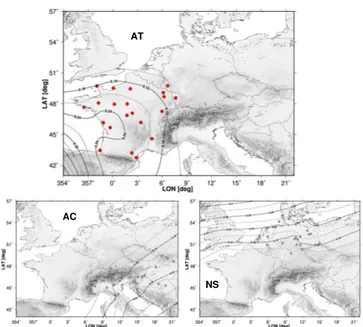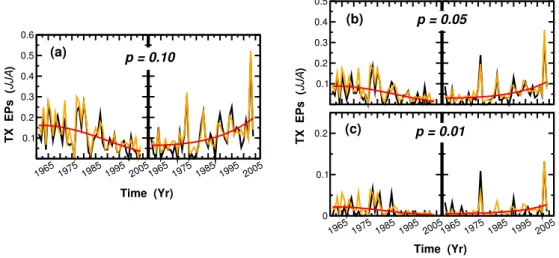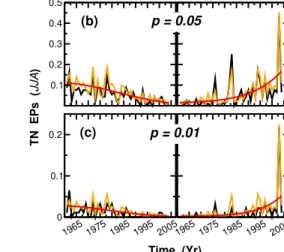Adv. Sci. Res., 8, 5–9, 2012 www.adv-sci-res.net/8/5/2012/ doi:10.5194/asr-8-5-2012
©Author(s) 2012. CC Attribution 3.0 License.
Advances
in
Science & Research
Open Access Proceedings
EMS
Ann
ual
Meeting
and
10th
European
Conf
erence
on
Applications
of
Meteorology
(ECAM)
2011
Extreme summer temperatures in Western Europe
C. Simolo1, M. Brunetti1, M. Maugeri2,1, and T. Nanni1 1
Institute of Atmospheric Sciences and Climate, National Research Council (ISAC-CNR), Bologna, Italy 2
Dipartimento di Fisica, Universit`a degli Studi di Milano, Italy
Correspondence to:C. Simolo (c.simolo@isac.cnr.it)
Received: 7 December 2011 – Revised: 6 February 2012 – Accepted: 7 February 2012 – Published: 17 February 2012
Abstract. We discuss the evolution of summer temperature extremes over Western Europe during 1961– 2004 in the context of current climate warming. Using a parametric approach, we investigate the role of properties and changes in probability density functions of daily temperatures in modifying the frequency of severe, isolated events. In this perspective, the recent intensification of extremely warm events over Europe turns out to be well consistent with a pure, nonuniform shift of mean values, with no room for conjectures about increasing temperature variability.
1 Introduction
European temperatures have undergone a considerable rise in the recent past, accompanied by marked changes in the fre-quency and magnitude of warm and cold extremes (Alexan-der et al., 2006; Moberg et al., 2006). The way such changes are controlled by changes in mean climatic con-ditions still needs to be understood. Exceptionally warm events, for instance, are generally thought to be triggered by increasing temperature variability on the daily or annual timescale (Sch¨ar et al., 2004; Della-Marta et al., 2007). Like-wise, modifications in the distributional shape of daily tem-peratures have been inferred from discrepancies between the observed behavior of moderate (so-calledsoft) extremes and that expected under a pure shift of mean temperatures (Klein Tank and K¨onnen, 2003; Klein Tank et al., 2005). Although such a climate shift seems inadequate to explain the recent intensification of unusually warm events, there is no clear observational evidence for changes in the statistical proper-ties beyond the mean (e.g. Scherrer et al., 2005; Simolo et al., 2010, 2011).
A key-point is therefore to investigate the relationships be-tween the behavior of severe, isolated events and the aver-age distributional properties of daily temperatures. Here we provide an appropriate theoretical framework to determine the exact nature of these relationships, that is, for translat-ing basic properties and long-term trends in the moments of probability density functions (PDFs) of daily temperatures into changes in the frequency of warm and cold extremes.
This formalism is here used to examine the summer evo-lution of daily temperatures over a Western European sub-domain, where the past decades have seen a strong warming that caused well-known record-breaking events, and is pro-jected to be even more severe in the near future (e.g. Fischer and Sch¨ar, 2009; Hirschi et al., 2011). Using this case as a baseline, we show how the observed evolution of soft ex-tremes can be understood in the light of a pure shift of mean temperatures, with no need for invoking more complicated changes in the second and higher moments. For further de-tails see Simolo et al. (2011).
A brief description of the data used and their processing is given in Sect. 2. A model for time-evolving daily temper-ature PDFs and soft extremes is discussed in Sect. 3. Main results are then illustrated in Sect. 4 by direct comparison with observations. Conclusions are finally drawn in Sect. 5.
2 Observations
AT
AC
NS
Figure 1. European areas (AT, AC and NS, see text) defined by Principal Component Analysis. Red dots in the upper panel denote locations of the 21 stations retained in the AT sub-domain. Loadings of Varimax rotated empirical orthogonal functions are also shown.
Atlantic (AT) area (see Fig. 1). Unweighted spatial averages were then derived for each sub-domain and for both TX and TN anomalies. Data availability and quality allowed to cover 1961–2007 over AC and NS and 1961–2004 over AT. Here we focus on summer (JJA) temperature evolution across the AT sub-domain, and refer to Simolo et al. (2011) for a com-prehensive discussion. The observed evolution of soft ex-tremes, i.e. those events confined to the outermost few per-cent tails of daily PDFs, is conventionally measured as day-counts per year (or season) exceeding/not exceeding fixed thresholds. We consider percentile-based indicators (Alexan-der et al., 2006) for gradually smaller fractions of the cold and the warm tail in TX PDFs, i.e. TXN, with N=10,5,1 andN=90,95,99 respectively, and similar for TN.
3 PDFs and soft extremes
Potential variations in the second and higher moments of daily temperature PDFs, as already noted, are usually de-duced indirectly from anomalous behaviors of distribution tails. Here, reversing the point of view, we determine the time evolution of cold and warm extremes from observed properties and changes in daily temperature distributions. A theoretical model is used for describing time-evolving PDFs and their basic features (Sect. 3.1). The ensuing changes in soft extremes can be determined within this framework in terms of time-dependent exceedance probabilities (EPs), i.e. total probabilities for events exceeding/not exceeding fixed thresholds (Sect. 3.2). As an example, the whole formalism
is adjusted for the TX and TN summer evolution over the AT region, as will be discussed in Sect. 4.
3.1 A time-evolving skewed density (TESD) model The most prominent changes in European temperatures con-cern the increase of the mean, whereas no significant trends during the recent past have been clearly detected in the sec-ond and higher moments, except only for weak seasonal ef-fects (e.g. Scherrer et al., 2005; Moberg et al., 2006). This is-sue has been addressed in Simolo et al. (2011) by a moment-based analysis of the empirical PDFs, derived from single-year sub-samples of TX and TN anomalies for the three European areas over their respective periods (see Sect. 2). In all cases the time series of second and higher moments did not reveal significant trends, but random fluctuations only (Simolo et al., 2011). The strongest warming was de-tected over the AT region, with a marked summer trend in both TX and TN mean values, which is only approximately linear in time and best fitted by a second-degree polynomial (see Fig. 2a). Similar to the other European areas, either on the annual or seasonal timescale, the AT summer PDFs were found to be essentially stationary in shape, though the shape itself shows departures from normality that are related to the degree of asymmetry.
Modeling observed PDFs therefore requires a skewed ex-tension of the normal density function, i.e.
f(z)=2φ(z)Φ(αz), where
φ(z)= √1
2πexp −
z2 2 !
, and Φ(αz)= Z αz
−∞
dyφ(y). (1)
Here, the shape parameterαcontrols the degree of asymme-try, with a left (right) skewed density defined byα <0 (>0) and the usual normal density by α=0. A location ξ and a scale parameter ω are restored by setting z=(x−ξ)/ω. Model parameters can be estimated, e.g., by the method of moments. The performance of the skewed density (Eq. 1) in fitting daily temperature data was thoroughly assessed in previous works (Simolo et al., 2010, 2011), and is here illus-trated in Fig. 2b, c for TX and TN summer anomalies of the AT regional series. Since, as stated above, time averages of second and higher moments are preserved by the evolution of European temperatures, the skewed density (Eq. 1) can be assumed as the fixed-shape PDF underlying daily anoma-lies. Time dependence can be then imposed on the model PDF through a change in the location parameterξonly, while keeping the scale and shape parameters constant across the full period and equal to their long-term averages. Hence,
z→z−∆ξ(t)
ω , ∆ξ(t)=ξ1t+ξ2t
2
, ω=ω¯ and α=α,¯ (2)
1960 1970 1980 1990 2000 -2
0 2 4 (K)
(a) TXTX fit
TN TN fit
-10 0 10
(K)
0 0.1 0.2
(b) TX PDF Fit
-10 0 10
(K)
0 0.1 0.2
(c) TN PDF Fit
Figure 2.(a)Time evolution of mean summer anomalies for TX (black solid line) and TN (black dashed line) over the AT region, together with their second order polynomial fits (red and blue lines respectively).(b–c)Empirical versus model PDFs for detrended summer(b)TX anomalies altogether, and similar for(c)TN. Model parameters are given in Sect. 4.
0.1 0.2 0.3 0.4 0.5
TX EPs (
JJA
)
(b) p = 0.05
1965 1975 1985 1995 2005 1965 1975 1985 1995 2005
Time (Yr) 0
0.1
0.2 (c) p = 0.01
1965 1975 1985 1995 2005
Time (Yr) 0.1
0.2 0.3 0.4 0.5 0.6
TX EPs (
JJA
)
(a)
1965 1975 1985 1995 2005
p = 0.10
Figure 3.Modeled and observed evolution of TX EPs for AT summer anomalies and probabilities(a)p=0.10,(b)p=0.05 and(c)p=0.01. In all cases, black lines denote the observed frequencies of (left) cold and (right) warm extremes, i.e. TX10 and TX90, and similar. Red lines are expected EPs with location parameter given by Eq. (2), and yellow lines are point-wise, expected EPs (see text).
3.2 Expected EPs
Time-varying frequencies of cold and warm extremes, as measured by the percentile indicators (e.g. TX10 and TX90), have a straightforward, theoretical representation as EPs, re-spectively
F−(¯zp,t)= Z z¯p
−∞
dz f(z,t), and
F+(¯z1−p,t)= Z +∞
¯
z1−p
dz f(z,t) (3)
for a defined probabilityp(e.g.p=0.10 for, say, TX10 and TX90). The fixed thresholds, ¯zp and ¯z1−p are climatologi-cal values, uniquely determined by the conditionF−(¯zp,t0)=
F+(¯z1−p,t0) at a given initial time t0. In practice, changes over time in the frequency of soft extremes can be explic-itly predicted within this framework from observed changes in the distributional properties of daily anomalies, by esti-mating the appropriate TESD model parameters defined by
Eqs. (1)–(2). The inherent nonlinearity between changes in PDF moments and tails becomes apparent in this formalism, since the time evolution of EPs is controlled by the behavior of the underlying density function. For normal distributed data, for instance, rates of change in EPs scale exponentially in time, even for a uniform shift of the mean, as can be easily proved using Eqs. (1)–(3) withα=ξ2=0 (see Simolo et al., 2011 for details).
4 Comparing modeled and observed changes
1965 1975 1985 1995 2005
Time (Yr)
0.1 0.2 0.3 0.4 0.5 0.6
TN EPs (
JJA
)
(a)
1965 1975 1985 1995 2005
p = 0.10
0.1 0.2 0.3 0.4 0.5
TN EPs (
JJA
)
(b) p = 0.05
1965 1975 1985 1995 2005 1965 1975 1985 1995 2005
Time (Yr)
0 0.1
0.2 (c) p = 0.01
Figure 4.Same as Fig. 3, but for TN EPs.
The frequency of day-counts with JJA anomalies exceed-ing/not exceeding percentile thresholds are shown as a func-tion of time in Figs. 3–4 (black lines), for both TX and TN in the AT regional series and gradually less moderate extremes. The expected time-dependent EPs are obtained from Eq. (3) with p=0.10,0.05, and 0.01, and the same choice of the TESD model parameters defined by Eqs. (1)–(2), de-rived from observations. That is, the location ξ of the AT summer skewed density is let vary nonlinearly in time with coefficients obtained from fits of TX and TN mean anoma-lies (see Fig. 2a); estimates of average scale and shape pa-rameters are given by ¯ωTX=3.9 K, ¯αTX=1.3, ¯ωTN=2.4 K, and ¯αTN=−1.1 (Fig. 2b–c). As seen in Figs. 3–4, theo-retical EPs (red lines) nicely fit the observed evolution of both cold and warm extremes, in both TX and TN anoma-lies, down to p=0.01, thereby outlining the actual rates of change. This, in turn, implies that the observed changes in the frequency of soft extremes are in fact those expected from a forward, nonuniform shift of mean temperatures. This is even more clear if the prescription in Eq. (2) for a continu-ous time-evolution of the location parameter is replaced with point-wise, annual averages, obtained e.g. by adding back the residuals from the fits of mean anomalies. In all cases the observations are faithfully reproduced by the correspond-ing point-wise EPs (yellow lines in Figs. 3–4), as witnessed by the large fraction of the variance explained by the model, i.e.R2
∼0.86,0.77,0.49 (0,88,0.79,0.68) for TX (TN) and p=0.10,0.05,0.01 respectively, averaging over cold and warm tails. Several unusually intense anomalies in either TX or TN (e.g. the 1976 and 2003 heatwaves) are predicted with values of probabilities very close to the observed ones. This fact again stresses the prominent role of the mean, both long-term trends and fluctuations, in the time-evolution of soft ex-tremes.
Small discrepancies between model predictions and ob-servations can be ascribed to fluctuations in the second and
higher moments, not accounted for by the choice of aver-age scale and shape parameters in the TESD model. Nev-ertheless, these discrepancies are quite small throughout the period, with no pattern, signifying that predictions are not plagued by underestimated trends in variability and skew-ness.
5 Conclusions
To summarize, we illustrated a simple, theoretical model for predicting changes in the frequency of cold and warm ex-tremes from average distributional properties and changes in daily temperatures. The key-strength of the present approach is its ability to account explicitly for the inherent nonlinear-ity between PDF moments and tails. A detailed comparison of model predictions and observations over the past decades puts forward the prominent role of the mean in explaining the evolution of extreme summer temperatures over Western Eu-rope, including the occurrence of unusually intense events. In view of this, hypothesis of ongoing changes in the higher moments appear to be neither supported by the data, nor even required.
Acknowledgements. ECA data are archived at the database: http://eca.knmi.nl. This study has been carried out in the framework of the EU project ECLISE (265240).
Edited by: M. Brunet-India
Reviewed by: two anonymous referees
References
Alexander, L. V., Zhang, X., Peterson, T. C., Caesar, J., Gleason, B., Klein Tank, A. M. G., Haylock, M., Collins, D., Trewin, B., Rahimzadeh, F., Tagipour, A., Rupa Kumar, K., Revadekar, J., Griffiths, G., Vincent, L., Stephenson, D. B., Burn, J., Aguilar, E., Brunet, M., Taylor, M., New, M., Zhai, P., Rusticucci, M., and Vazquez-Aguirre, J. L.: Global observed changes in daily climate extremes of temperature and precipitation, J. Geophys. Res., 111, D05109, doi:10.1029/2005JD006290, 2006.
Della-Marta, P. M., Haylock, M. R., Luterbacher, J., and Wanner, H.: Double length of western European summer heat waves since 1880, J. Geophys. Res., 112, D15103, doi:10.1029/2007JD008510, 2007.
Fischer, E. M. and Sch¨ar, C.: Future changes in daily summer tem-perature variability: driving processes and role for temtem-perature extremes, Clim. Dynam., 33, 917–935, doi:10.1007/ s00382-008-0473-8, 2009.
Hirschi, M., Seneviratne, S. I., Alexandrov, V., Boberg, F., Boroneant, C., Christensen, O. B., Formayer, H., Orlowsky, B., and Stepanek, P.: Observational evidence for soil-moisture im-pact on hot extremes in southeastern Europe, Nat. Geosci., 4, 17–21, doi:10.1038/ngeo1032, 2011.
Klein Tank, A. M. G. and K¨onnen, G. P.: Trends in indices of daily temperature and precipitation extremes in Europe, J. Climate, 16, 3665–3680, 2003.
Klein Tank, A. M. G., Wijngaard, J. B., K¨onnen, G. P., B¨ohm, R., Demaree, G., Gocheva, A., Mileta, M., Pashiardis, S., Hejkr-lik, L., Kern-Hansen, C., Heino, R., Bessemoulin, P., Muller-Westermeier, G., Tzanakou, M., Szalai, S., Palsdottir, T., Fitzger-ald, D., Rubin, S., Capaldo, M., Maugeri, M., Leitass, A., Bukan-tis, A., Aberfeld, R., Van Engelen, A. F. V., Forland, E., Mietus, M., Coelho, F., Mares, C., Razuvaev, V., Nieplova, E., Cegnar, T., Antonio Lopez, J., Dahlstrom, B., Moberg, A., Kirchhofer, W., Ceylan, A., Pachaliuk, O., Alexander, L. V., and Petrovic, P.: Daily dataset of 20th-century surface air temperature and precip-itation series for the European Climate Assessment, Int. J. Cli-matol., 22, 1441–1453, 2002.
Klein Tank, A. M. G., K¨onnen, G. P., and Selten, F. M.: Signals of anthropogenic influence on European warming as seen in the trend patterns of daily temperature variance, Int. J. Climatol., 25, 1–16, 2005.
Moberg, A., Jones, P. J., Lister, D., Walther, A., Brunet, M., Ja-cobeit, J., Alexander, L. V., Della-Marta, P. M., Luterbacher, J., Yiou, P., Chen, D., Klein Tank, A. M. G., Saladie, O., Sigro, J., Aguilar, E., Alexandersson, H., Almarza, C., Auer, I., Barriendos, M., Begert, M., Bergstrom, H., Bohm, R., But-ler, C. J., Caesar, J., Drebs, A., Founda, D., Gerstengarbe, F. W., Micela, G., Maugeri, M., Osterle, H., Pandzic, K., Petrakis, M., Srnec, L., Tolasz, R., Tuomenvirta, H., Werner, P. C., Lin-derholm, H., Philipp, A., Wanner, H., and Xoplaki, E.: Indices for daily temperature and precipitation extremes in Europe ana-lyzed for the period 1901–2000, J. Geophys. Res., 111, D22106, doi:10.1029/2006JD007103, 2006.
Sch¨ar, C., Vidale, P. L., L¨uthi, D., Frei, C., H¨aberli, C., Liniger, M. A., and Appenzeller, C.: The role of increasing temperature variability in European summer heatwaves, Nature, 427, 332– 336, 2004.
Scherrer, S. C., Appenzeller, C., Liniger, M. A., and Sch¨ar, C.: European temperature distribution changes in observations and climate change scenarios, Geophys. Res. Lett., 32, L19705, doi:10.1029/2005GL024108, 2005.
Simolo, C., Brunetti, M., Maugeri, M., Nanni, T., and Speranza, A.: Understanding climate change-induced variations in daily tem-perature distributions over Italy, J. Geophys. Res., 115, D22110, doi:10.1029/2010JD014088, 2010.


